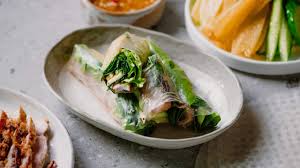A Traditional Vietnamese Delicacy
Vietnam is renowned for its diverse and flavorful cuisine, and one of the most beloved street food dishes is pork rice paper rolls. These rolls combine tender slices of pork, crunchy fresh vegetables, and aromatic herbs, all wrapped in delicate rice paper. Whether you’re exploring a local market in Hanoi or enjoying a seaside meal in Da Nang, you’re likely to come across this simple yet satisfying treat.
Why Locals Love It
Pork rice paper rolls are not just tasty—they’re also light, healthy, and easy to customize. Each roll is often paired with a rich hoisin-peanut dipping sauce or a tangy fish sauce blend, enhancing the fresh ingredients inside. The rolls are commonly eaten as an appetizer, a light lunch, or a refreshing snack on hot days.
What’s Inside a Roll?
A typical pork rice paper roll includes:
Thinly sliced boiled or grilled pork
Fresh lettuce, mint, and coriander
Cucumber and pickled carrots
Vermicelli noodles
Soft, translucent rice paper
Some variations may include shrimp or tofu, but pork remains the classic choice for many locals.
How to Eat and Enjoy
To enjoy these rolls the local way:
Dip each roll generously into the sauce.
Eat in one or two bites to appreciate the texture and flavor layers.
Pair with iced tea or a cold Saigon beer for a full Vietnamese experience.
Where to Find Pork Rice Paper Rolls
You’ll find pork rice paper rolls across Vietnam—on street food stalls, in casual eateries, or in family homes. If you’re traveling in Central Vietnam, cities like Hoi An and Hue offer unique local versions.
Learn more about other Vietnamese street food dishes
Discover how to make rice paper rolls at home with this authentic recipe from Vietnam
Health Benefits of This Local Favorite
Thanks to the abundance of raw vegetables and lean pork, pork rice paper rolls are:
Low in fat
Rich in fiber and protein
Perfect for gluten-free diets (if no noodles are used)
Final Thoughts
Whether you’re new to Vietnamese food or a long-time fan, pork rice paper rolls are a must-try. They’re more than just a dish—they’re a cultural experience that brings freshness, flavor, and tradition together in every bite.
